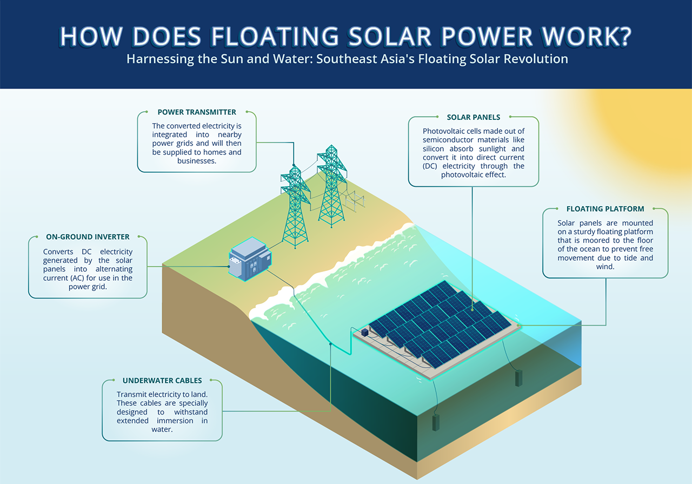Faced with the urgent need to transition to clean energy, Southeast Asia is emerging as a frontrunner in the adoption of floating solar power. With abundant water resources, progressive policies, and strategic geographical conditions, the region is poised to become a global hub for floating solar energy by 2030.
The Rise of Floating Solar Photovoltaics
Floating photovoltaic (FPV) technology has witnessed exponential growth in recent years. Global capacity soared from a mere 70 megawatt-peak (MWp) in 2015 to approximately 7,000 MWp by 2028. Industry forecasts predict an impressive 58% CAGR over the next decade, with the global floating solar market expected to reach a staggering USD 1,375.49 billion by 2031—an exponential leap from its USD 38.50 billion valuation in 2023.
For Southeast Asia—a region characterized by rapid economic development, escalating energy demands, and limited land availability—floating solar presents an exceptionally appealing solution. It enables the generation of clean energy without consuming valuable terrestrial space and offers additional benefits such as reduced water evaporation from reservoirs and enhanced solar panel efficiency due to the cooling effect of water. Floating solar is becoming a pivotal element in the region’s clean energy strategy.

How Do Floating Solar Panels Work?
Floating solar panels operate on the same principle as traditional solar panels, converting sunlight into electricity via photovoltaic cells. The key difference lies in their placement; these panels are installed on large bodies of water such as lakes, reservoirs, and coastal areas. Polyethylene floats keep the panels buoyant and properly oriented towards the sun.
One of the primary advantages of FPV systems is their increased power output efficiency compared to land-based installations. The surrounding water acts as a natural coolant, preventing the panels from overheating and thus maintaining optimal operating temperatures. This cooling effect can enhance efficiency by up to 11%, allowing the panels to generate more electricity over longer periods.
Moreover, FPV systems contribute to water conservation. By covering portions of water surfaces, they reduce evaporation rates—a significant benefit in regions prone to water scarcity. This conservation is particularly valuable for hydroelectric dams, where preserved water levels can enhance hydropower generation, and for irrigation reservoirs that support agriculture.
Perhaps the most compelling aspect of FPV technology is its ability to produce clean energy without consuming valuable land resources. This feature is especially beneficial for land-constrained Southeast Asian nations, where competition for land use is intense.
Southeast Asia Leading the Charge
Southeast Asia is one of the fastest-growing economic regions globally, boasting a combined GDP of over USD 3 trillion. This growth trajectory brings with it an ever-increasing demand for energy. Recognizing this, the Association of Southeast Asian Nations (ASEAN) has set a collective renewable energy capacity target of 35% by 2025.
Overcoming Challenges and Accelerating Growth
While FPV systems offer immense promise, they are not without challenges. Concerns regarding product durability, system stability, environmental impacts, and grid integration need to be addressed.
Extreme weather events, exacerbated by climate change, pose risks to FPV installations. The damage sustained by the world’s largest planned floating solar plant at India’s Omkareshwar Dam during a 2024 storm underscores the need for robust engineering and design standards capable of withstanding such conditions.
Environmental considerations are also paramount. Introducing large structures into aquatic ecosystems may affect water quality and aquatic life by altering sunlight penetration and disrupting biological processes like photosynthesis.
To maximize the potential of floating solar power, collaboration between academia, industry, and governments is essential. Research partnerships can focus on refining designs, enhancing energy efficiency, and mitigating environmental impacts.
Strategic alliances between the public and private sectors are also crucial. Governments can facilitate growth by implementing supportive policies such as feed-in tariffs and tax incentives. For instance, Malaysia offers substantial tax incentives like the Capital Allowance (CA) and Green Investment Tax Allowance (GITA), which can cover up to 48% of the investment cost for companies installing solar systems. Vietnam has introduced specific guidelines for floating solar projects, providing clarity for investors and developers.
The Need for Regional Cooperation
Despite the promising outlook, widespread adoption of floating solar in Southeast Asia faces challenges beyond technology. Ensuring energy supply security amidst exponential demand growth necessitates building infrastructure and establishing common energy market frameworks.
An interconnected ASEAN power grid would facilitate efficient energy distribution, improve supply security, and support the integration of renewable energy sources. However, the region’s fragmented energy landscape—with varying policies, regulations, and market structures—poses a significant hurdle.
Caroline Chua, a Singapore-based analyst from BloombergNEF, highlights this complexity: “Many are seeking cleaner alternatives to coal-fired generation as they look to meet this rising need for electricity. Harmonizing policies, regulations, and cross-border market operations will be crucial if the goal is to connect ASEAN’s grids.”
Addressing these challenges requires a comprehensive strategy involving financial support, knowledge sharing, local empowerment, and targeted skill development to foster a more integrated and sustainable floating solar sector across Southeast Asia.
A Floating Future for Southeast Asia
Southeast Asia is poised to be a pioneer and major contributor to the floating solar industry in the coming years. The unique advantages of floating solar—land conservation, enhanced energy production efficiency, and suitability for the region’s geography—make it an ideal solution for meeting growing energy demands sustainably.
As countries across Southeast Asia continue to invest in and expand their floating solar capabilities, they are not only addressing immediate energy needs but also making significant contributions to global efforts in combating climate change. The floating solar revolution in Southeast Asia serves as a powerful example of how innovative technologies, decisive policy actions, and regional cooperation can drive meaningful transitions toward a sustainable future.

